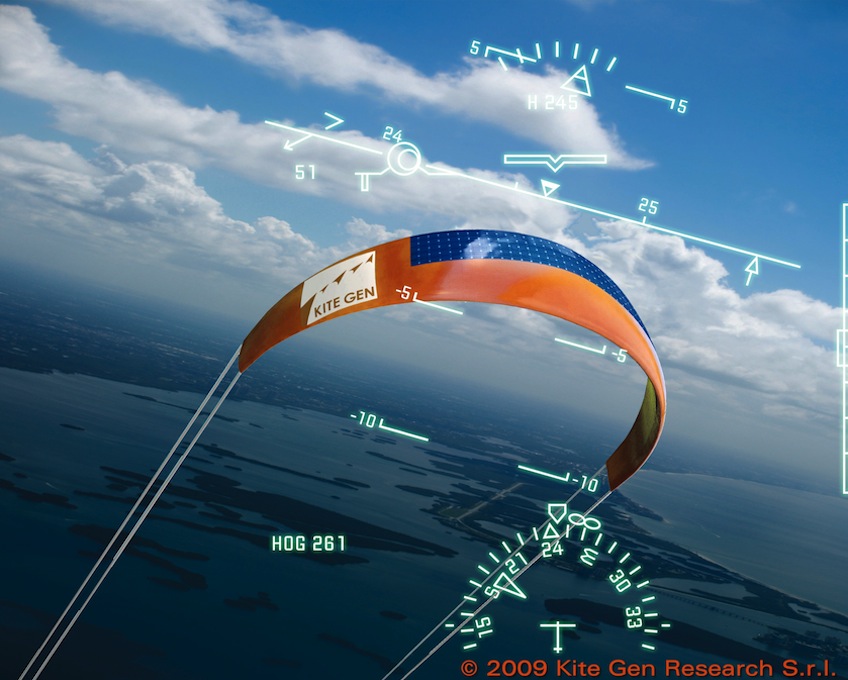There’s a band of people in the northwest hills of Italy who are fishing for the big one in the sky.
They’re not a religious sect trawling for a deity. They’re part of a Turin-based startup called Kite Gen Research and, as their name implies, they want to generate electricity by flying kites — really big kites, really high.
The basic idea is simple: Unreel a huge piece of fabric into mile high winds that will haul the thing along at expressway speed. Tether the fast spinning string to earthbound alternators and crank out megawatts of power.
“Imagine you have a fishing rod, but instead of a fish, you have a kite,” says Stefano Serra, a Kite Gen consultant. “The fish pulls away. Just attach an alternator to the reel, and you produce energy.”
Or, as Kite Gen president and founder Massimo Ippolito likes to say in describing the physics, “It’s not our invention. It’s the wind.”
Image courtesy of KiteGen.
A CONSTANT HOWL
What Ippolito means is that Kite Gen is leveraging the laws of nature. Higher altitude winds blow more constantly than those at ground level. According to Ippolito, the winds he’s targeting are available for 6,000 hours a year, compared to what he says can average 1,500 hours for conventional ground wind turbines.
The higher altitude winds are also faster than on the ground.
And any increase in wind speed yields an even greater increase in wind power, as wind power is the cube of its speed so even small increases in speed can lead to big boosts in power. If wind is streaming at 20 mph on the ground while traveling double that, or 40 mph, at 3,000 feet, its power at altitude would be 8 times the power on ground.
THE HIGHEST ENERGY DENSITY POWER
The physics of wind power means that the high altitude wind sources like the jet stream – the current of air that gushes along at around 4.3 to 9.8 miles high, typically at over 100 mph — are among the most coveted.
“It’s the highest energy density of renewable power source available on Earth,” says climate scientist Ken Caldeira at the Carnegie Institution for Science at Stanford University. He notes that the raw power of the jet stream can reach 30,000 watts per square meter and can typically be 10,000 watts per square meter, compared to an average of 300 watts per square meters for solar on the Earth’s surface.
“But it’s a little bit like the fusion power of the renewable energy world,” says Caldeira, “where it’s not something that’s practical economically today.”
Ippolito is after a more modest goal. He thinks that winds at Kite Gen’s altitudes of between between half a mile to just over a mile high will on average run at double the speed of ground wind.
Another advantage: The kite sweeps across a three-dimensional area of a square kilometer – 100 times more than what Ippolito notes is the conventional two-dimensional, one-hectare sweep of a conventional wind blade.
The net effect, says Ippolito, is an “energy returned on energy invested” (EROEI) that’s 160 times better than conventional wind turbines.
WANTED: GOOD MECHANICS
Unlike other airborne wind energy companies like Sky Windpower in San Diego and Makani Power in Alameda, Calif., Kite Gen is not sending down electricity.
Instead, it is transferring energy mechanically via a rapidly unravelling string made from Dyneema, a polyethylene material manufactured by Dutch company DSM that as consultant Serra notes “looks like a shoe lace but can lift a car.”
Two strings reel out from spinning drums attached to alternators — KiteGen calls the units “STEMS”. Once the wind pulls out the full length of the strings, one of the strings tugs on one end of the kite, pulling it limply back down for about 20 seconds, and then releasing it back to the wind for about two minutes, in a yo-yo motion.
There are a total of 8 alternators, combining for a capacity of 3.2 megawatts per STEM – enough for a small utility scale generation. Ippolito envisions clustering scores of STEMs together on farms with hundreds of megawatts of capacity. He’s using kites that measure about 50 square meters (about 538 feet) and imagines lofting kites three times that size.
IN CONCEPT WE TRUST
Kite Gen has launched numerous trials in Sommariva Perno, a municipality in the Piedmont area of Italy about 25 miles southeast of Turin, and about 1,312 feet above sea level. “We’ve proven the concept,” says Ippolito.
The engineering is still a work in progress. The company is testing different kite fabrics – it has used nylon and Dacron, and will examine carbon fiber. The STEM system includes low-tech pulleys and manipulators (two fingers that pull on the kite strings from the end of a long rod) and a high-tech IT system with sensors and software that keep the kite at optimal altitudes and angles.
Things tend to break. “We are dealing with energy that is not a joke – energy that exerts huge forces,” Ippolito explains.
The company hopes to raise $62 million to perfect its technologies and build a 150-megawatt farm of about 50 STEMs. It wants to bring in industrial partners and other sources of financing to pick up from the $12 million it has raised from a combination of the European Union and private investors, including Ippolito, Serra, and a group called SOTER (Society for the Transition to Renewable Energy).
The additional funds could well help Kite Gen cast away its engineering barriers. Then, the company could potentially land a big fish in the pursuit of CO2-free energy. Otherwise, it might tell the tale of the one that got away.
Originally appeared on Ecomagination





Comments